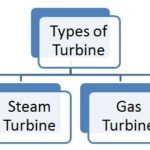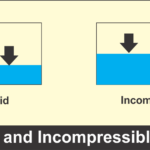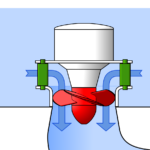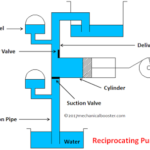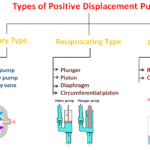Working Principle
It works on the principle of forced vortex flow. The forced vortex flow means when a certain mass of fluid or liquid is allowed to rotate by an external torque than there is a rise in pressure head of the rotating liquid takes place. This rise in pressure head is used to deliver water from one location to another. It is centrifugal force acting on the fluid that makes it to flow within the casing.
The rise in the pressure head of the rotating liquid at any point is directly proportional to the square of the tangential velocity of the rotating liquid.
Mathematically
How liquid is lifted to high level?
At the outlet of the impeller, radius is more and because of this the rise in the pressure head is more and the liquid at the outlet discharged with a high pressure head. And because of this high pressure head, the liquid can be lifted to a very high level.
Also Read:
Pelton Turbine Working, Main Parts, Application with Diagram
Reciprocating Pump – Main Parts, Types, Working, Advantages, Disadvantages with Application
Main Parts
The various main parts of a centrifugal pump are:
- Impeller
- Casing
- Suction pipe with a foot valve and strainer
- Delivery pipe
Let’s discuss about each one of them one by one
1. Impeller
It is the rotating part of the pump. The impeller is mounted on a shaft and the shaft of impeller is again connected with the shaft of an electric motor. It is rotated by the motor and consists of series of backward curved blades.
2. Casing
It is an air tight passage which surrounds the impeller. The design of the casing is done in such a way that it is capable of converting the kinetic energy of the water discharging from the outlet of the impeller into pressure energy before it leaves the casing and enters into the delivery pipe.
Commonly three types of casing are used in centrifugal pump and these are
(i). Volute Casing: It is a spiral type of casing in which the area of flow increases gradually. The increase in area of flow decreases the velocity and increases the pressure of the liquid that flows through the casing. The volute casing is shown in figure above:
(ii). Vortex Casing: In vortex casing, a circular chamber is introduced in between the impeller and casing. This is done in order to prevent the loss of energy due to formation of eddies. The efficiency of the vortex casing is more than that of the volute casing.
(iii). Casing with Guide Blades: In this casing, the impeller is surrounded by series of guide blades. The guide blades are mounted on a ring which is called as diffuser. The design of the guide vanes are kept as such that the water which is leaving the impeller enters the guides without shock. The area of the guide vanes increases; this helps to decrease the velocity of the liquid and increases its pressure. After guide vanes, water passes through the surrounding casing. In most of the cases, the casing remains concentric with the impeller.
Also Read:
What is Positive Displacement Pump – Definition, Types and Working?
3. Suction Pipe with Foot Valve and Strainer
A pipe whose one end is connected with the inlet of the impeller and the other end is dipped into the sump of water is called suction pipe. The suction pipe consists of a foot valve and strainer at its lower end. The foot valve is a one way valve that opens in the upward direction. The strainer is used to filter the unwanted particle present in the water to prevent the centrifugal pump from blockage.
4. Delivery Pipe
It is a pipe whose one end is connected to the outlet of the pump and other end is connected to the required height where water is to be delivered.
Working
- As the electric motor starts rotating, it also rotates the impeller. The rotation of the impeller creates suction at the suction pipe. Due to suction created the water from the sump starts coming to the casing through the eye of the impeller.
- From the eye of the impeller, due to the centrifugal force acting on the water, the water starts moving radially outward and towards the outer of casing.
- Since the impeller is rotating at high velocity it also rotates the water around it in the casing. The area of the casing increasing gradually in the direction of rotation, so the velocity of the water keeps on decreasing and the pressure increases, at the outlet of the pump, the pressure is maximum.
- Now form the outlet of the pump, the water goes to its desired location through delivery pipe.
What is priming and why it is necessary?
It is process in which the suction pipe, casing and delivery pipe upto the delivery valve is filled completely with liquid to be raised from outside source before starting the motor. Priming is done to remove the air from the pump.
If air is not removed from the pump than a small negative pressure is created at the suction pipe and it cannot suck the water from the water sump. So it is advised to fill the pump with water before starting it.
Application
The centrifugal pump is used in almost every field to raise the liquid from low level to high level. They are mostly used at home for filling water tanks, almost in every industry such as chemical, automobile, marine, manufacturing, for irrigation etc.



